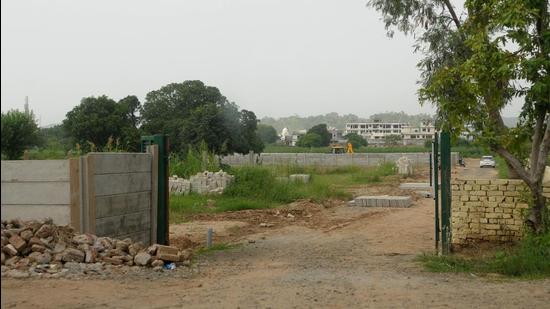Chandigarh has no plans to extend lal dora limits in its villages
Lal dora is the red line that separates village habitation from adjacent agricultural land; Chandigarh adviser Dharam Pal said illegal constructions outside this limit will have to be demolished as Chandigarh plans to roll out a land pooling policy and village development plan
Laying to rest all speculations about the extension of lal dora — the red line that separates village habitation from adjacent agricultural land—in UT villages, adviser Dharam Pal said there are no such plans and illegal constructions outside the limit will have to be demolished, “preferably” by the violators themselves as the administration prepares to roll out a land pooling policy and village development plan.

The adviser clarified, “At the moment there is no plan to extend the lal dora. It is not under consideration.”
The speculation had gained momentum in the past few months after the administration started working to formulate a policy for regularisation of illegal constructions outside lal dora.
In January this year, former UT administrator VP Singh Badnore had directed UT officials to bring a comprehensive policy on the issue.
The administration has roped in the Indian Institute of Human Settlement (IISH), Bengaluru, to formulate a land pooling and aggregation policy. In a recent meeting with the IISH representatives, the first draft of the policy was discussed. During the meeting, the adviser directed the UT urban planning department to devise a plan for village development. In addition to it, to bring more clarity on lal dora, the deputy commissioner’s office was directed to provide demarcated lal dora areas to the planning department.
Political parties and village residents have been consistently asking for the extension of lal dora and regularisation of constructions outside it. Architects and city’s heritage conservationists are demanding that these illegal constructions should be removed to protect the city’s character. Hundreds of cases are pending in the high court and SDM courts on the issue.
With municipal corporation elections a little over two months away, the lal dora extension will be a key issue as villages’ votes are likely to make difference for a party to cross the winning seat marks in the MC House.
Regularising illegal constructions
The Punjab New Capital Periphery Control Act restricts constructions in the periphery of around 16km (controlled area) of the city, which covers the areas outside the lal dora. Punjab and Haryana high court has also imposed restrictions on construction for protection of Sukhna Catchment Area.
The planning department has consistently flagged large-scale illegal construction and colonisation in villages of Chandigarh. Administration recently authorised three sub divisional magistrates (SDM) to demolish any new construction outside lal dora.
But constructions continue to crop up in most villages such as Kishangarh-Manimajra, Hallomajra, Maloya, areas around Bapu Dham near Sukhna Choe, Khuda Ali Sher and Kaimbwala etc.
For instance, in Khuda Ali Sher village, even advertisement boards can be spotted offering land for sale. Walled bifurcated plots are available with internal roads, drinking water supply, sewerage, and electricity connections. Most of these advertisements are for farmhouses. But overtime, land is bifurcated multiple times to form smaller plots. Also, small hutments get converted into bigger houses gradually, say local residents.
On the regularisation of large-scale illegal constructions outside the lal dora, the adviser, said, “After the administration finalises the village development plan and land pooling policy, the violators will have to go as per that plan. They will have to first demolish their unauthorised constructions, and get their new constructions, if permitted, as per the plan.”
“Once land pooling policy comes into force, people may pool their resources and demolish unauthorised buildings and go for authorised ones. After leaving space for parks, roads, etc, people will be allowed to create residential and commercial spaces. That will be a huge incentive for people to go for legal structures and demolish illegal ones,” said Pal.
The draft land pooling policy is expected to be ready in a month’s time.





